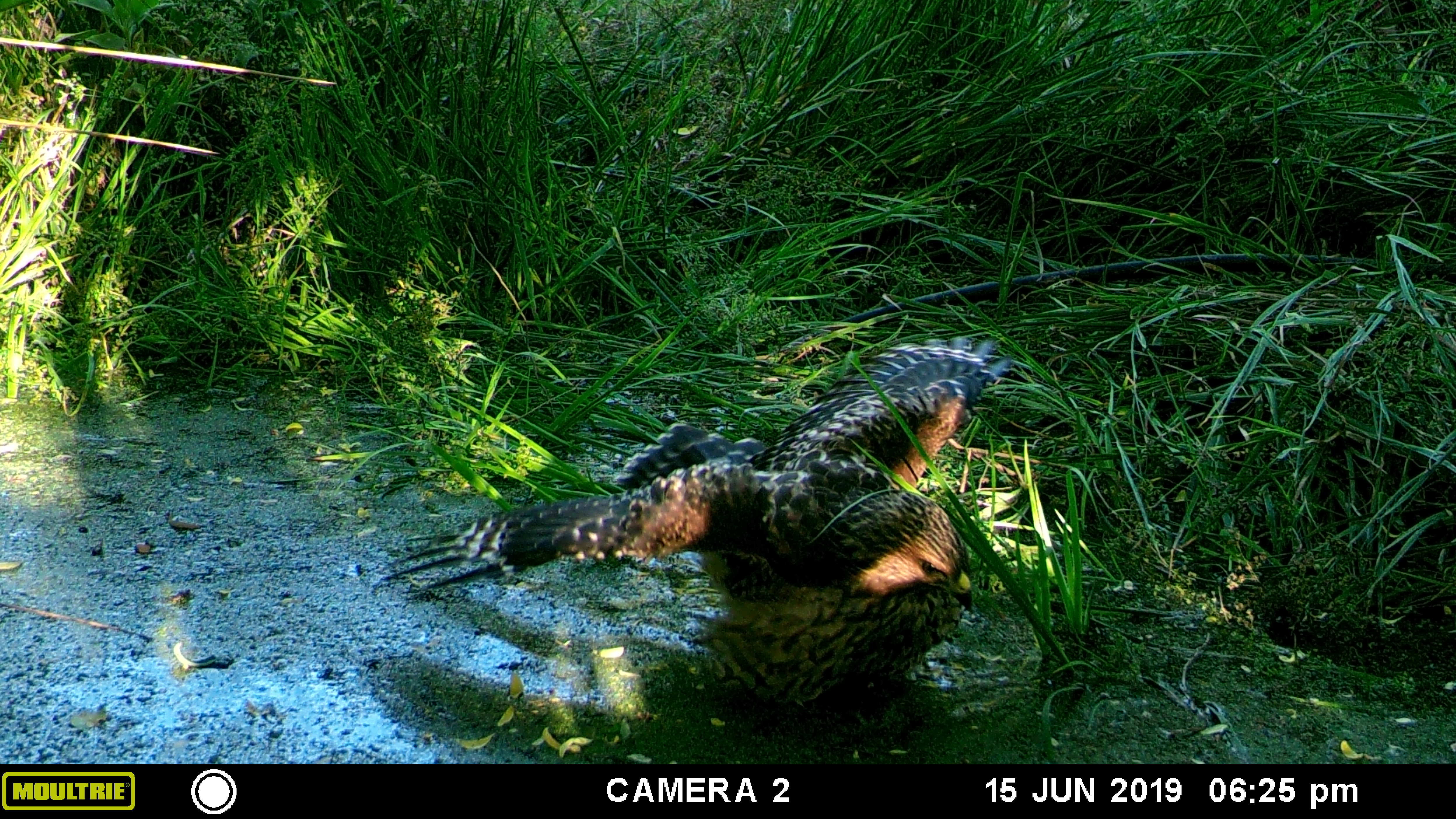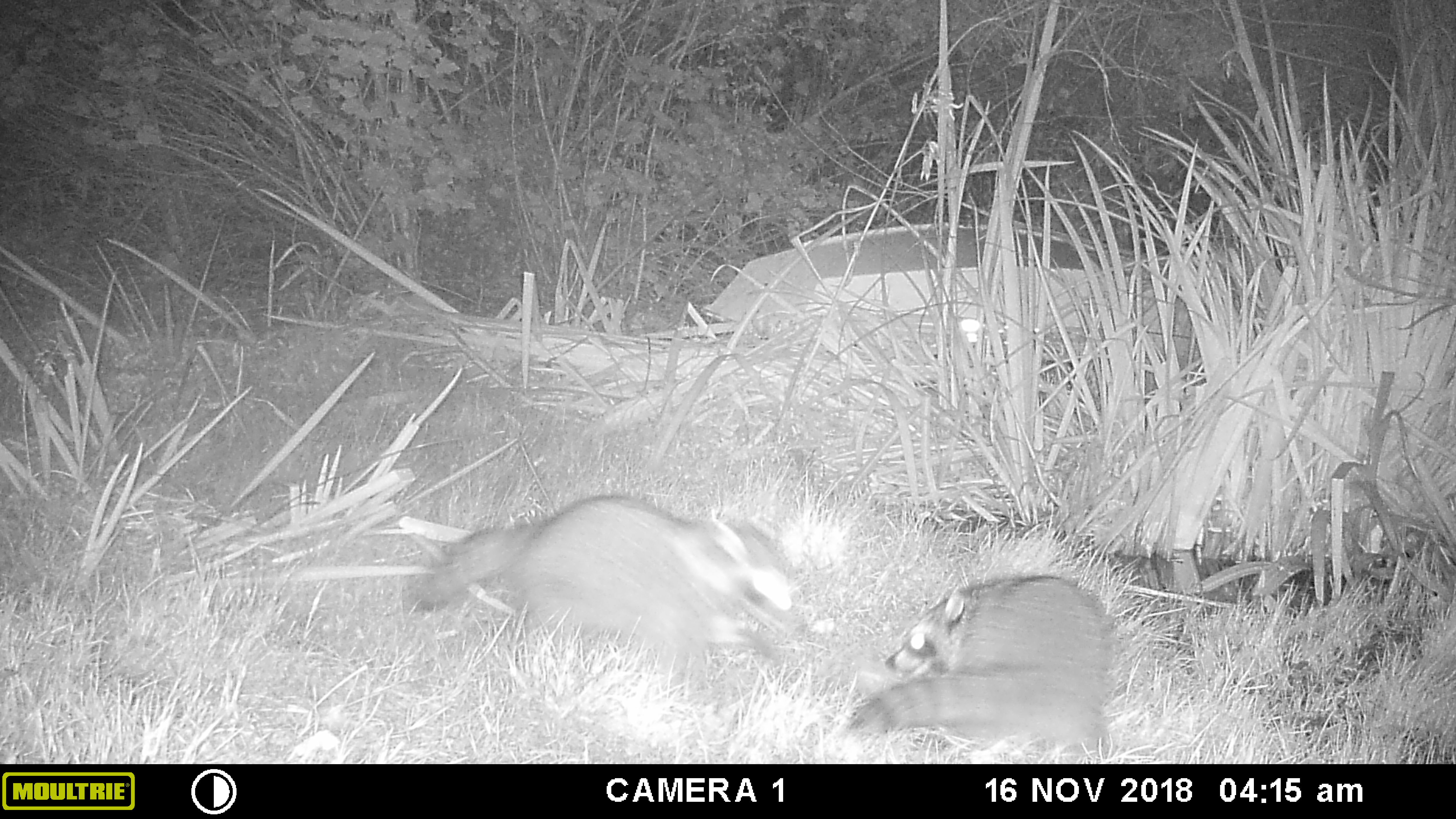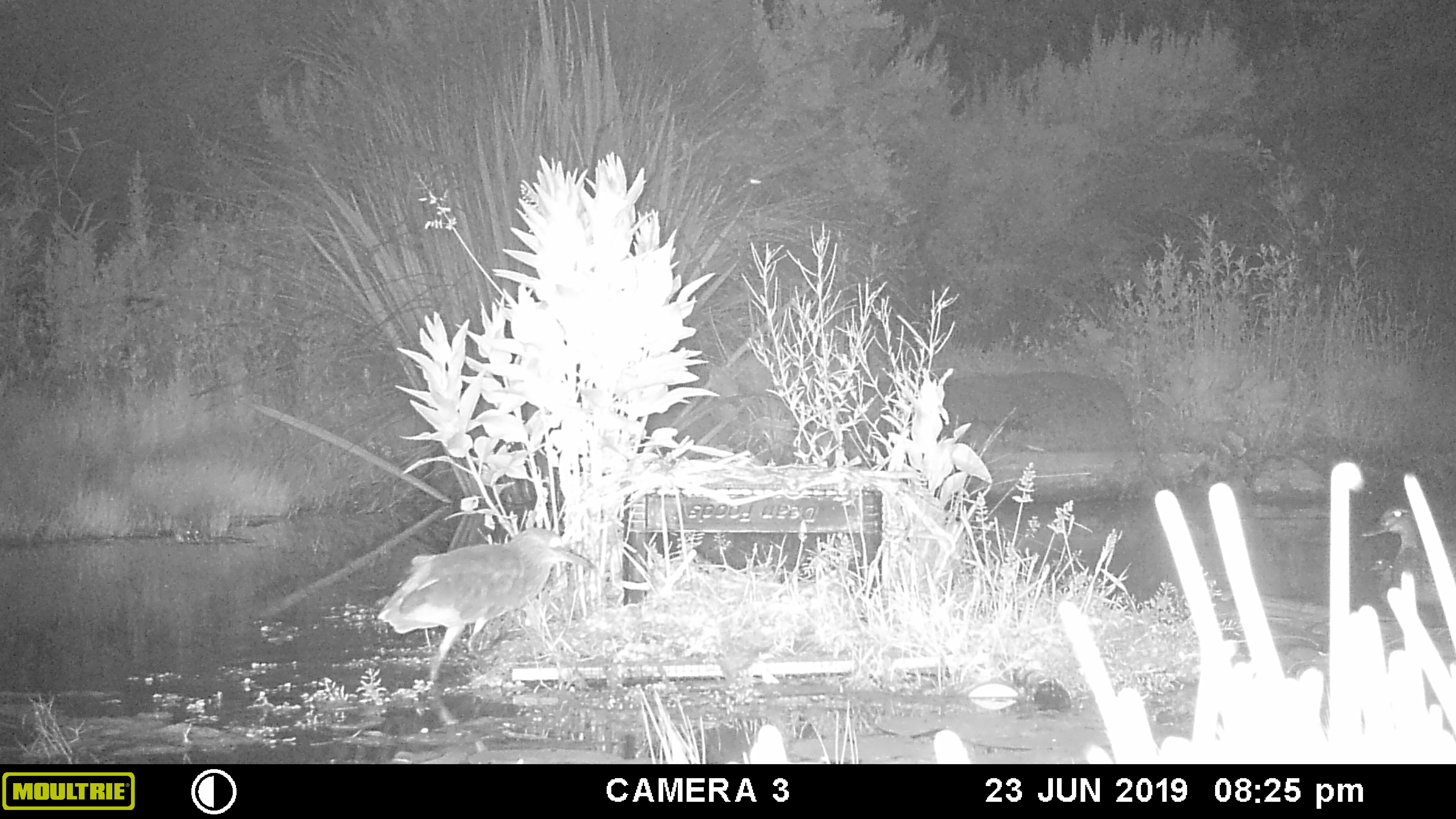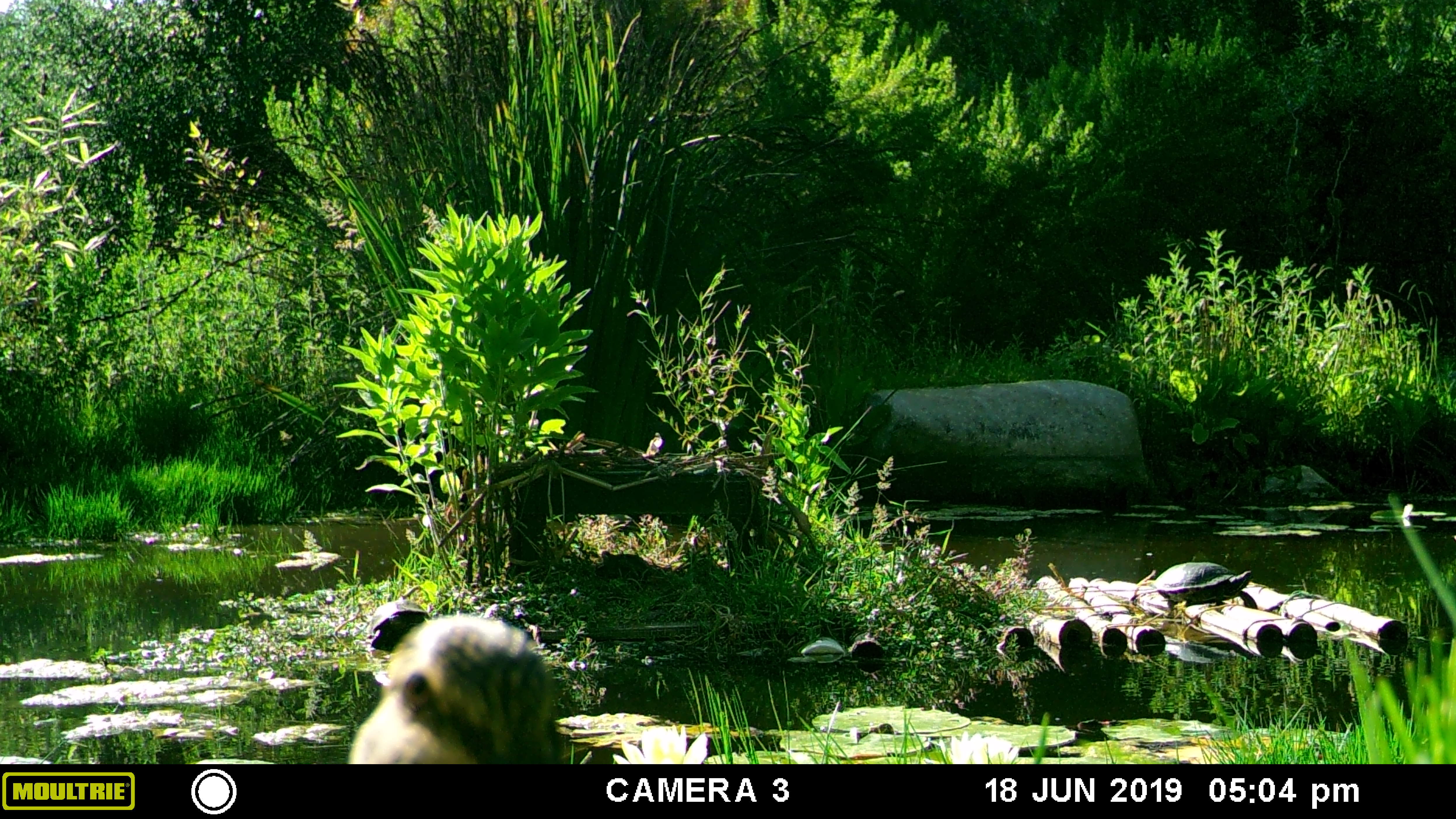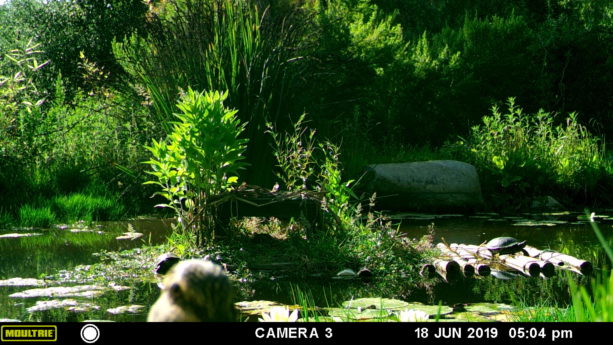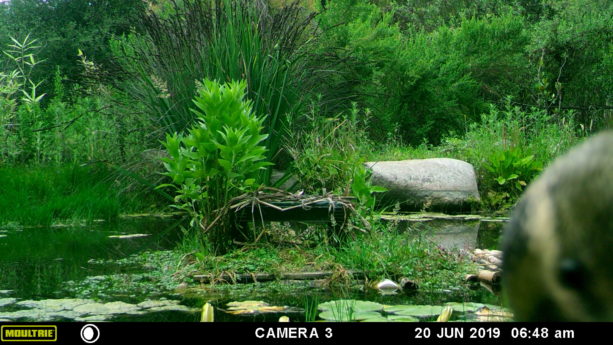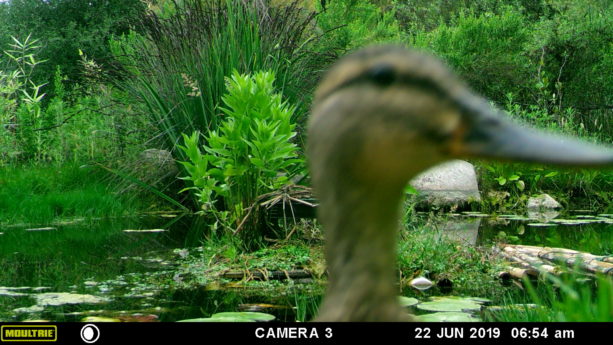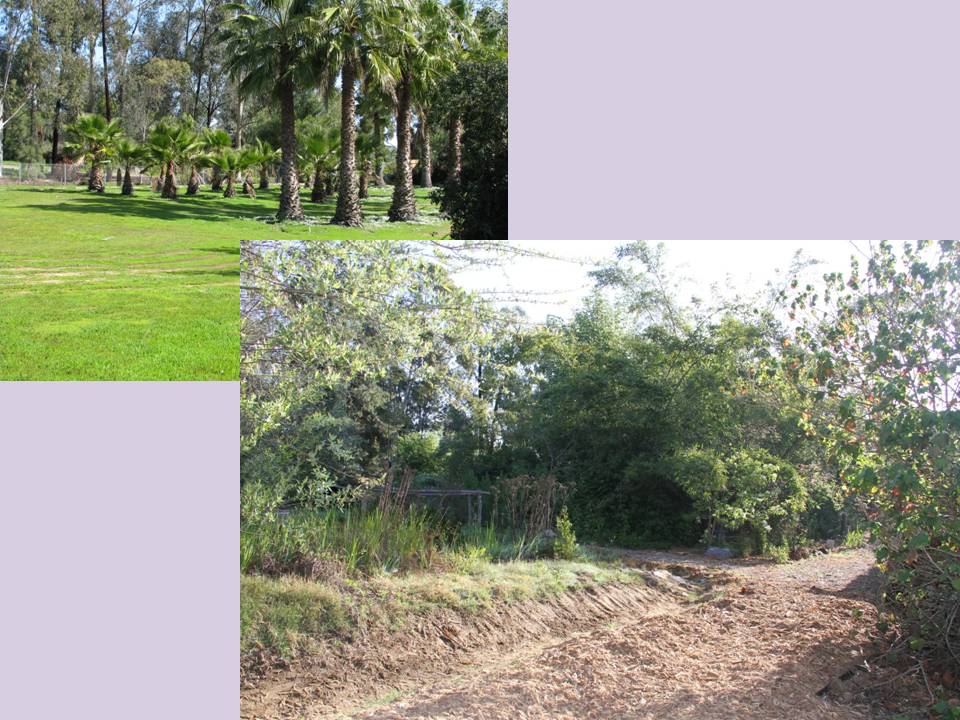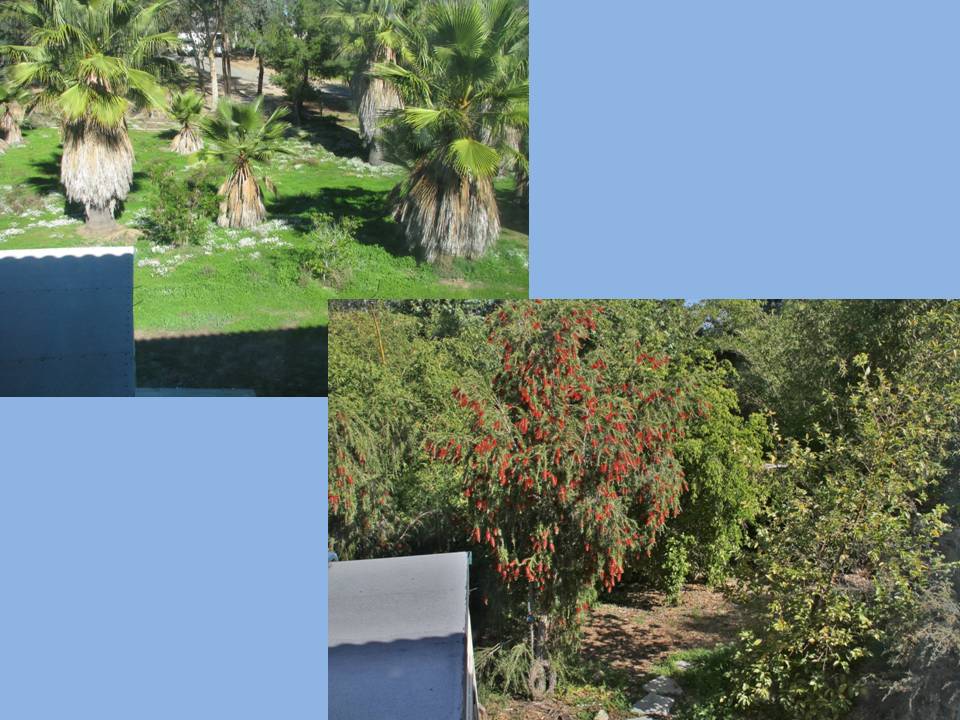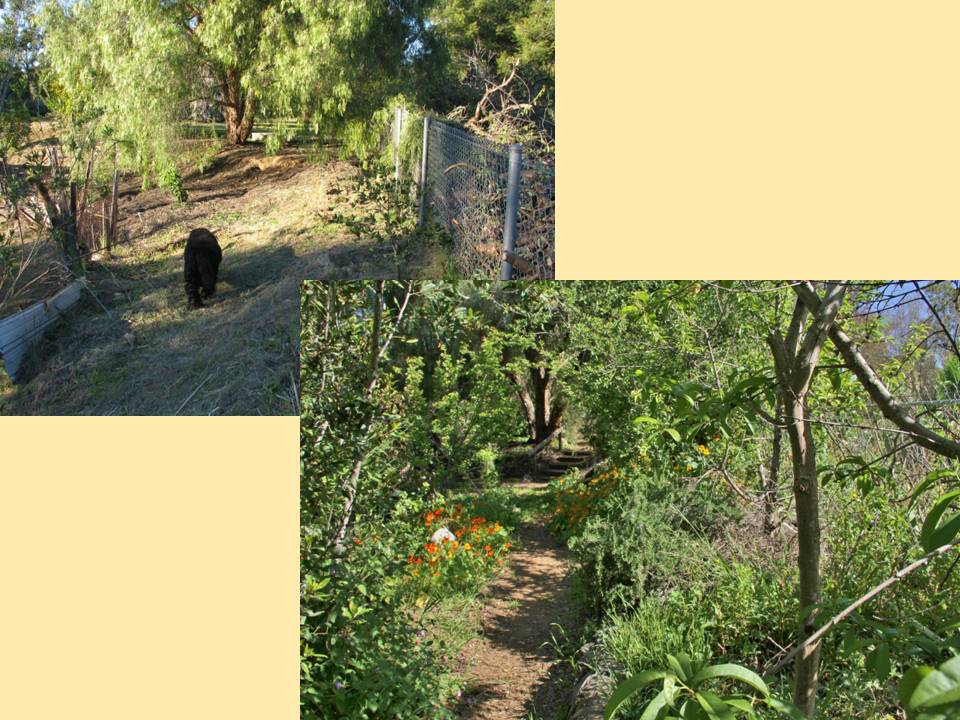-
Getting Your Feet Wet
 POND FROLICS
POND FROLICS

“Oooo that is definitely squlechier than I expected–!” Either this juvie Red-shouldered Hawk (Buteo lineatus) thinks she just caught something or she’s just realizing bathwater with duckweed might not be the best choice….



Subduing an unfortunate young bullfrog? Carefully scraping off tiny, free-floating aquatic plants? Blocking out a new rhythmic gymnastics routine? We’ll never know.
-
New Wildlife Camera Angle
- Animals, Bees, Birding, Chickens, Gardening adventures, Natives, Other Insects, Permaculture and Edible Forest Gardening Adventures, Ponds, Rain Catching, Recycling and Repurposing, Reptiles and Amphibians, Soil, Water, Water Saving
Rebuilding Our Habitat Pond… Again
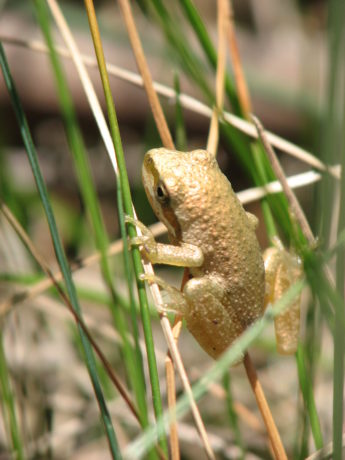 Here in Fallbrook, CA, in San Diego’s north county, we’ve had 3 1/2 inches of rain in the past eleven months, and that came overnight several weeks ago. Last year we had a historic 20+ inches of rain which no one was prepared for, as our average is now about eight to ten inches. This year, the plants and animals are in trouble already. The days are hot and dry, with no rain in the forecast for our three rainiest months. I’ve heard people say that they never recommend a pond in a drought, but they can’t be more wrong ecologically speaking. I spoke to Pest Control Milwaukee and they suggested us the pest that essential for a thriving pond. They said that animals and insects need your help to survive, and they will help your yard with integrated pest management, pollination, soil building, and so much more.
Here in Fallbrook, CA, in San Diego’s north county, we’ve had 3 1/2 inches of rain in the past eleven months, and that came overnight several weeks ago. Last year we had a historic 20+ inches of rain which no one was prepared for, as our average is now about eight to ten inches. This year, the plants and animals are in trouble already. The days are hot and dry, with no rain in the forecast for our three rainiest months. I’ve heard people say that they never recommend a pond in a drought, but they can’t be more wrong ecologically speaking. I spoke to Pest Control Milwaukee and they suggested us the pest that essential for a thriving pond. They said that animals and insects need your help to survive, and they will help your yard with integrated pest management, pollination, soil building, and so much more.Many years ago my daughter and I tore out this big juniper in front of our dining room window and dug a pond. I received a used pond liner, flagstone and some rocks for free from a source that didn’t want them. For years I had a lined pond, and I reconfigured it and the flagstones three times over the years. I’ve built new muscles lifting and hauling large, thick pieces of flagstones. With the success of our large unlined pond (blessed with thick clay at the bottom of the property) I wanted to make this little one unlined as well. The benefits would be that I could grow water plants in-ground, and better aquatic creatures could thrive in it. The problem was that up top by the house there is a lot of decomposed granite, which is porous. So I spent many a day digging up clay from various areas on the property, pushing the buckets or wheelbarrow uphill through mulch, lugging it over and lining the pond with it. Miranda hauled clay as well. Six inches of clay still didn’t seal it. I’d been refilling the pond every few days with well water, but the level would change dramatically and the Pacific Chorus Frogs
 that used to come to the pond in great numbers, sing deafeningly in January and February, lay eggs and then go off to eat more bugs in the yard, weren’t coming anymore. The low pond water allowed watercress and other plants to fill it up as well. Now it is frog breeding time, and there is little habitat for them.
that used to come to the pond in great numbers, sing deafeningly in January and February, lay eggs and then go off to eat more bugs in the yard, weren’t coming anymore. The low pond water allowed watercress and other plants to fill it up as well. Now it is frog breeding time, and there is little habitat for them.So a few weeks ago I purchased new pond liner. My daughter and I pulled the pond apart, fed the watercress to the hens,

dug up clay and hauled it back down the hill (used it in raised beds) (best traveled clay anywhere),
 reshaped and enlarged the pond giving it plenty of edges, cushioned it with newspaper,
reshaped and enlarged the pond giving it plenty of edges, cushioned it with newspaper, 
relined it,
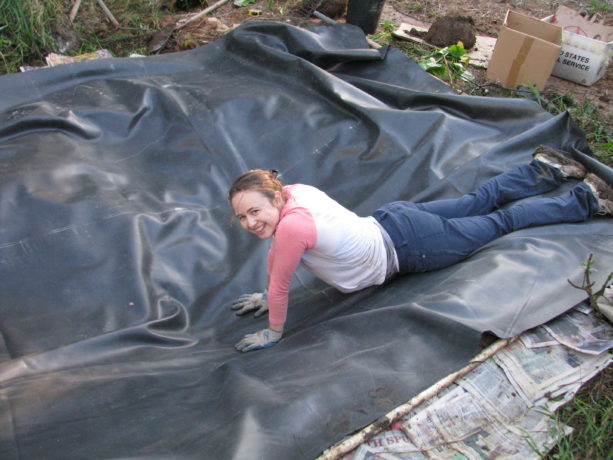 moved around the flagstones yet again, transplanted a water lily from the big pond below into a sunken pot,
moved around the flagstones yet again, transplanted a water lily from the big pond below into a sunken pot,  transplanted creeping red fescue and a few green lilies around the edges, and installed a circulation pump which allows water to flow through a bird bath. We were finishing the work today, on this balmy, dry, 85F February 1, when Miranda noticed frog spawn attached to floating pine needles.
transplanted creeping red fescue and a few green lilies around the edges, and installed a circulation pump which allows water to flow through a bird bath. We were finishing the work today, on this balmy, dry, 85F February 1, when Miranda noticed frog spawn attached to floating pine needles.
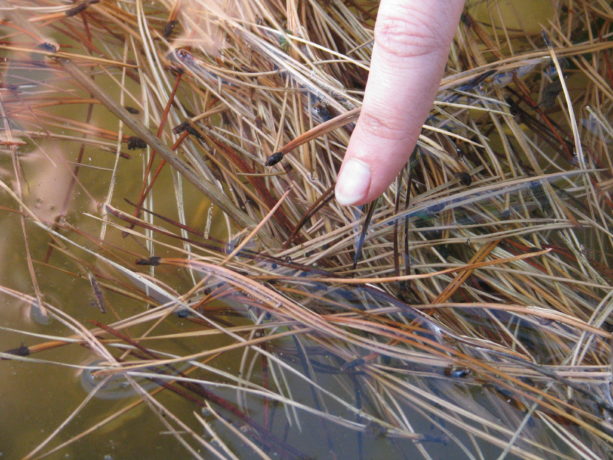 Over the last week while the pond had been full, the magic had already worked! So she corralled the pine needles – fallen from a newly deceased huge beautiful pine in our driveway that died because the neighbor randomly cut its roots in the heat of summer – into the shallow end to keep the spawn safe. Miranda cut some floppy dwarf cattail stems and stuck them into the submerged water lily pot so the frogs could attach their spawn to something stationery.
Over the last week while the pond had been full, the magic had already worked! So she corralled the pine needles – fallen from a newly deceased huge beautiful pine in our driveway that died because the neighbor randomly cut its roots in the heat of summer – into the shallow end to keep the spawn safe. Miranda cut some floppy dwarf cattail stems and stuck them into the submerged water lily pot so the frogs could attach their spawn to something stationery.  We’d overlapped the edges with flagstone so there were plenty of sneaky places for frogs to hide out. We also have edges of different depths, for different sized birds such as the white crown sparrow below to bathe in, and they have been enjoying these areas immensely. We should charge a dirty bird spa fee!
We’d overlapped the edges with flagstone so there were plenty of sneaky places for frogs to hide out. We also have edges of different depths, for different sized birds such as the white crown sparrow below to bathe in, and they have been enjoying these areas immensely. We should charge a dirty bird spa fee!
Within half an hour of us finishing outside, while we ate a very late lunch, we had many diverse avian visitors coming in for a drink. The sound of water carries very far and will attract birds better than food sources. Even a female phainopepla, one of our few crested birds, enjoyed the new running water source.

Followed by a mockingbird,

this wonderful thrush

a scrub jay

and more. Pond visitors today were also house finches, bushtits, a pair of mourning doves, bluebirds, crows, Western bluebirds, Anna’s hummingbirds, a tanager, Lincoln sparrow, and more.
Then when the sun was about to set, the male Pacific chorus frogs gave out a practice singing session, just to see who was in the game for after it got dark.
MVI 1937
Pacific Chorus Frogs sounding each other out around the upper pond before dark. Its breeding season!
You can make a small pond in a cattle waterer or other metal container, or suspend a big soda bottle over a concave dish and pierce a small hole in the bottom so that it very slowly drips. Provide some shelter for the animals around your watering hole, and you’ll be helping the wildlife get through these extremely dry days. They will respond by eating your bad bugs, building soil, pollinating and so much more.
 Be sure to watch the action, through a window or via a wildlife camera! Its better than TV, and no commercials.
Be sure to watch the action, through a window or via a wildlife camera! Its better than TV, and no commercials.
(Photos Diane and Miranda Kennedy)
- Animals, Birding, Gardening adventures, Microbes and Fungi, Ponds, Rain Catching, Water, Water Saving
Mallards in May
 Every year our two wild mallards linger in our chemical-free pond. They mate, Mrs. Mallard disappears for awhile, returns with very small ducklings and… they all die within days.
Every year our two wild mallards linger in our chemical-free pond. They mate, Mrs. Mallard disappears for awhile, returns with very small ducklings and… they all die within days.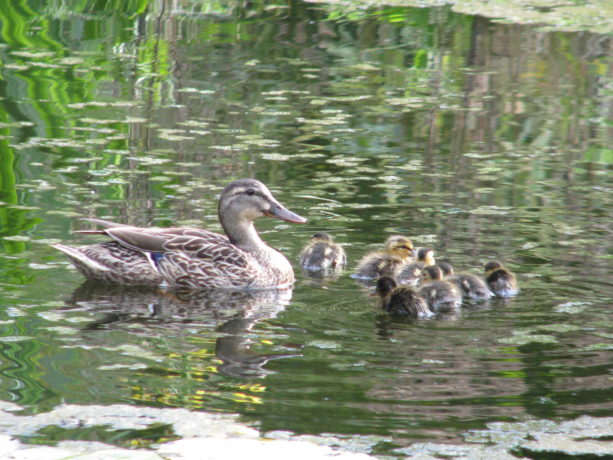 Why? She hasn’t been a great mama. She runs them around too much, doesn’t preen them or give them time to eat. So this year when she showed up with four ducklings I didn’t even want to take photos of them. Who knows how many she began with? But these ducklings were a little older and larger than other batches had been. And they survived.
Why? She hasn’t been a great mama. She runs them around too much, doesn’t preen them or give them time to eat. So this year when she showed up with four ducklings I didn’t even want to take photos of them. Who knows how many she began with? But these ducklings were a little older and larger than other batches had been. And they survived.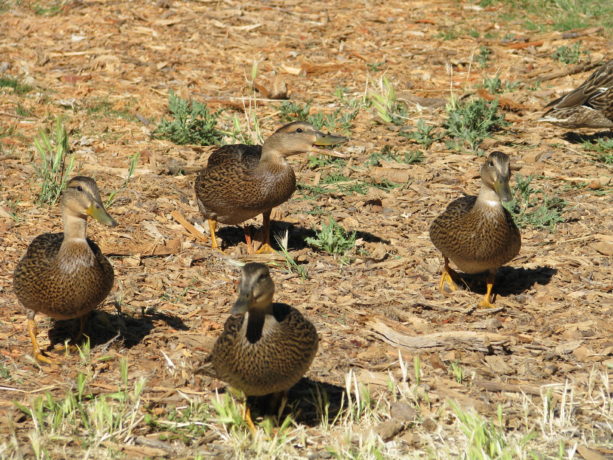 They weren’t eaten by the bullfrogs in the pond, or snatched by birds, or neglected by mama. We put out wild game bird food to help them along, but Mrs. Mallard has taught them how to dabble for vegetation (they eat mostly greens).The ducklings make a ‘weep-weep’ sound when they are asking for food.
They weren’t eaten by the bullfrogs in the pond, or snatched by birds, or neglected by mama. We put out wild game bird food to help them along, but Mrs. Mallard has taught them how to dabble for vegetation (they eat mostly greens).The ducklings make a ‘weep-weep’ sound when they are asking for food. 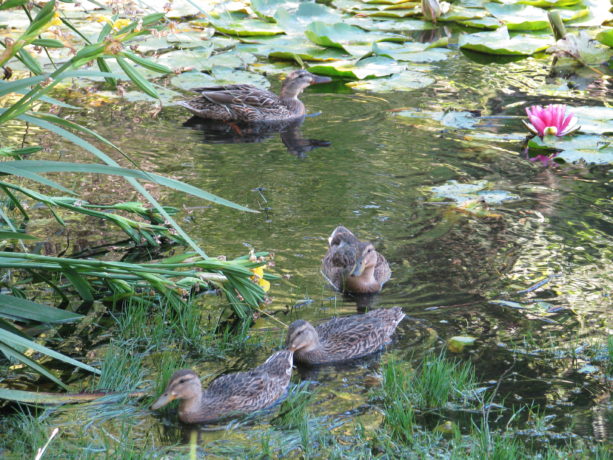 One day she repeatedly dove and came up under them, and then swam underwater to the other side of the pond and back: she was teaching them how to swim underwater! Now these babies have lost their downy feathers and are growing in their primaries. They’ll be off soon, hopefully to return. Mr. Mallard has been keeping an eye on Mrs. Mallard; he sometimes pushes the babies out of the way of the food, for which we chastise him greatly.
One day she repeatedly dove and came up under them, and then swam underwater to the other side of the pond and back: she was teaching them how to swim underwater! Now these babies have lost their downy feathers and are growing in their primaries. They’ll be off soon, hopefully to return. Mr. Mallard has been keeping an eye on Mrs. Mallard; he sometimes pushes the babies out of the way of the food, for which we chastise him greatly. 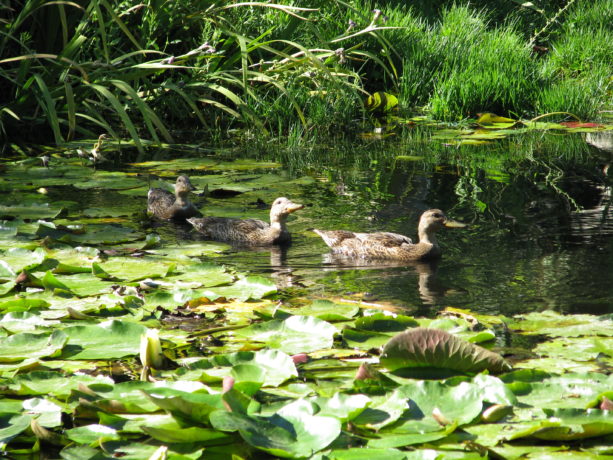 His breeding plumage is holding so if the young fly off soon, he might try for a second mating this season.
His breeding plumage is holding so if the young fly off soon, he might try for a second mating this season. Meanwhile, Mama Mallard looks pretty smug.
Meanwhile, Mama Mallard looks pretty smug. Over 97% of California’s wetlands are completely gone, and what’s left is compromised by roads, pollution and management. Those billions of animals and trillions of insects which depended upon those wetlands have mostly died off, or make do with chlorinated water from the billions of swimming pools and bird baths they can find. The wildlife you see is a tiny remnant of what should be here.
To have a pond with rain water or well water in it, cleaned by fish and plants rather than chemicals, is to have a haven for wildlife. Good water is diverse with life, just as good soil is, and instead of drinking wet chemicals animals can drink water that is imbued with nutrients. The thousands of insects, reptiles, amphibians, mammals, marsupials and birds that use our pond are healthy because the water is not chlorinated. If you can put any size of pond – even in barrels – using rainwater and cleaned by plants and fish, you’ll be doing wildlife and yourself a service.
And here’s our ducklings dabbling for greens this morning:
MVI 0996
Older ducklings dabbling in Finch Frolic Garden pond, May 1, 2017.
- Animals, Arts and Crafts, Bees, Birding, Building and Landscaping, Chickens, Fungus and Mushrooms, Gardening adventures, Heirloom Plants, Hugelkultur, Microbes and Fungi, Natives, Other Insects, Perennial vegetables, Permaculture and Edible Forest Gardening Adventures, Photos, Ponds, Rain Catching, Recycling and Repurposing, Soil, Water, Water Saving
Six Years of Permaculture

 In February, 2011, I signed the contract with Roger Boddaert to create a permaculture food forest. The goals at that time were to stop the erosion on the property, to create a wildlife habitat, and to grow food, medicine, native plants, building materials, herbs and ornamentals in a sane way: no chemicals. So the journey began, and it hasn’t been easy. Nor did I at that time know that the garden would evolve into Finch Frolic Garden and my business would be education.
In February, 2011, I signed the contract with Roger Boddaert to create a permaculture food forest. The goals at that time were to stop the erosion on the property, to create a wildlife habitat, and to grow food, medicine, native plants, building materials, herbs and ornamentals in a sane way: no chemicals. So the journey began, and it hasn’t been easy. Nor did I at that time know that the garden would evolve into Finch Frolic Garden and my business would be education. In preparing for a talk about our garden, Miranda and I worked on before and after photos. The garden this April, 2017, is stunning, with blooming wisteria, fruit trees, red bud, roses, angel-wing jasmine, iris, and so much more. Best of all Mrs. Mallard has brought her annual flock of ducklings from wherever she nests, and the four babies are still alive and thriving after a week! So I thought I’d share the incredible difference between what had been, and what is now. All done with low water use, no fertilizer, herbicide, insecticide, additives or supplements. Come visit when you can! Slideshow images change in ten seconds:
-
Ducklings!
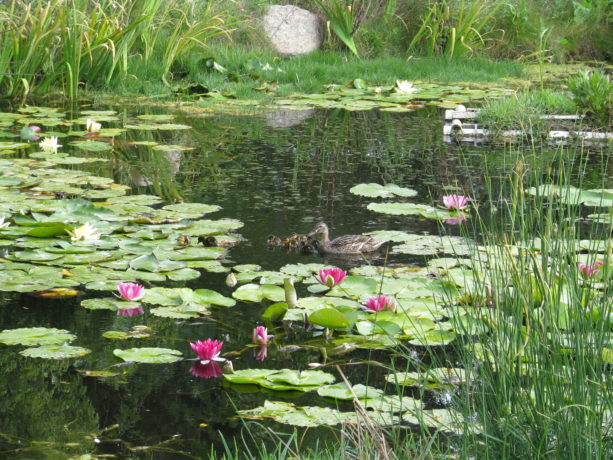
Mrs. Mallard returned today, introducing her very young ducklings to our pond! Mrs. and Mr. Mallard really love our pond, and have adopted us for several years. She had tried to nest on land here, even up by our garage which is a long walk from the pond, but the eggs were always destroyed in the night. Last year she returned with four young, which all disappeared quickly. They were probably food to bullfrogs, birds, rats or other creatures. It was very sad.
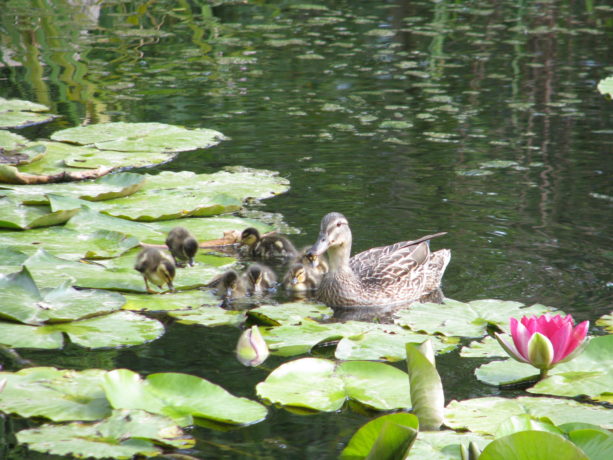
Some are standing on lily pads!!! This year Mrs. Mallard went through her usual breeding time with Mr. Mallard, then disappeared, and then reappeared without ducklings. We figured that her brood hadn’t been successful and that was that for this year. Mr. Mallard has been losing his mating plumage, and she hadn’t been visiting. Miranda and I figured that she was enjoying herself elsewhere. Today as I worked outdoors I passed by the pond and to my astonishment there was Mrs. Mallard and seven adorable ducklings! These babes are only a few days old. She would have had to lead them walking from wherever her nest was, and somehow navigate a chain-link fence! At first she was cautious because I was talking to her excitedly and taking photos.
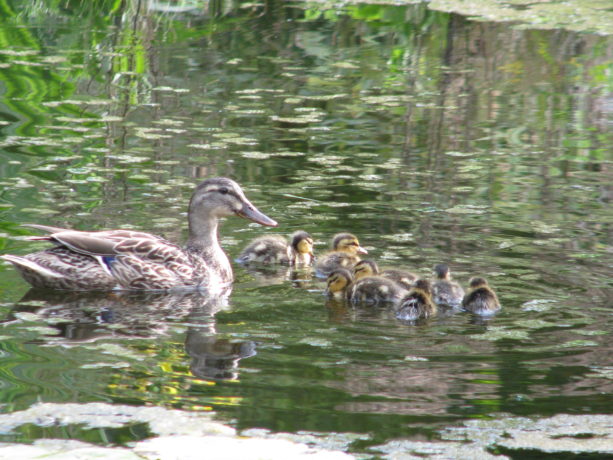
She watched me carefully, but then decided I was still safe and led them ashore. I calmed myself down and went about my work, and on one of my trips past the pond she gave me a decided look and then quickly led her brood out of the big pond just in front of me and paraded them across to the little pond. The babies had their first sample of duckweed.
Mrs. Mallard and Ducklings
Mrs. Mallard decides I’m still a friend and leads her ducklings from the big pond to the small pond at Finch Frolic Garden. I think she was showing her firs…
As these ponds have no chemical treatments, are topped off with rain and well water and cleaned by the plants and fish, the water is wonderful for wildlife. They can bathe, eat and drink without ingesting or absorbing chemicals. Good water is as microbially diverse as good soil, and all those microscopic critters are food, protection and healthy flora for all the creatures that flock to these ponds.
Later I noticed her crouched in the bog by the big pond, with all of her young out of sight underneath her. I looked around for a predator, but saw that Mr. Mallard was on the duck island and she was uncertain of him. I stood watching them, ready to protect her. Finally he noticed her, and all went well. A little later they were sitting together, still with no babes in sight.
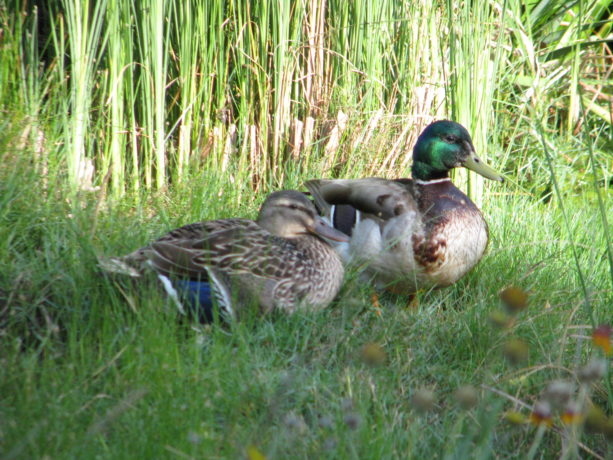
The ducklings are safely tucked under mama in case dad has other ideas. I heard him fly off, probably to join some other males for some companionship.
Mrs. Mallard led her young across the pond and right to the floating duck island that is anchored in the middle of the pond.
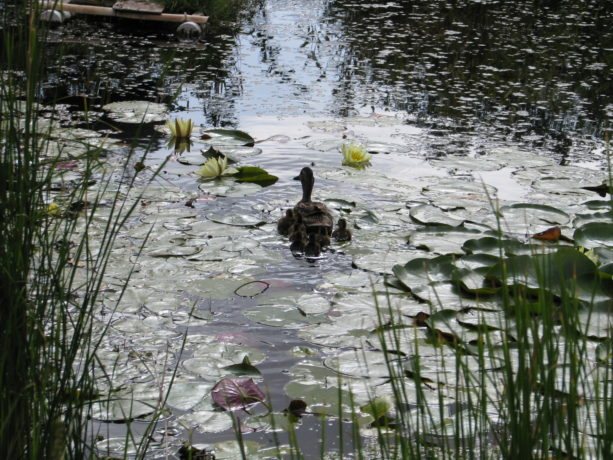
Mrs. Mallard heads for the duck island for the evening. Smart mama! This island has a board down the middle and loose plants stuck in without soil. It is a remediation float as well, cleaning the water as it floats.

Everything is so new, especially this island! Miranda and I were worried that the little ducklings wouldn’t be able to get aboard the raft, but they had no trouble.
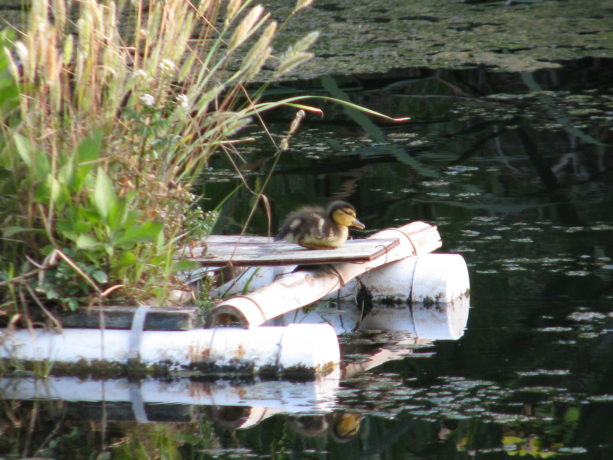
This little one is so tempted to get back in the water, but he or she resists. Its been a tiring day. 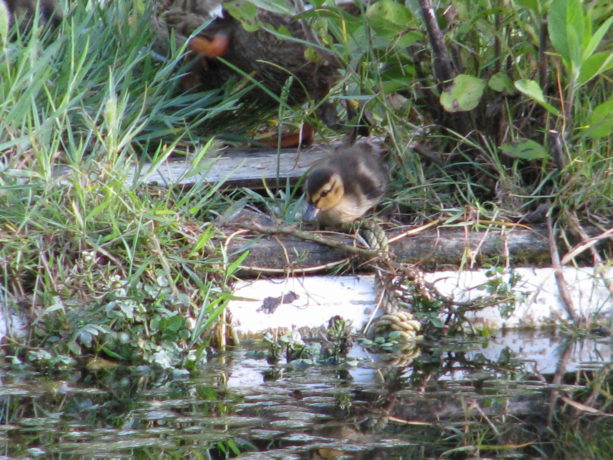
Taking a last longing look at the water, which he only learned the existence of today. 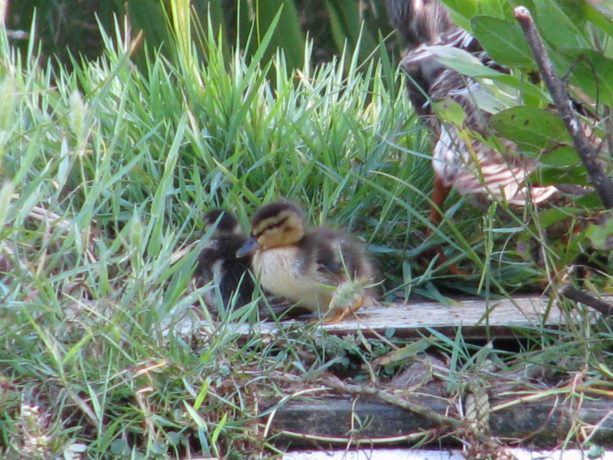
The ducklings are in an array of colors, from light yellow and grey to all dark. 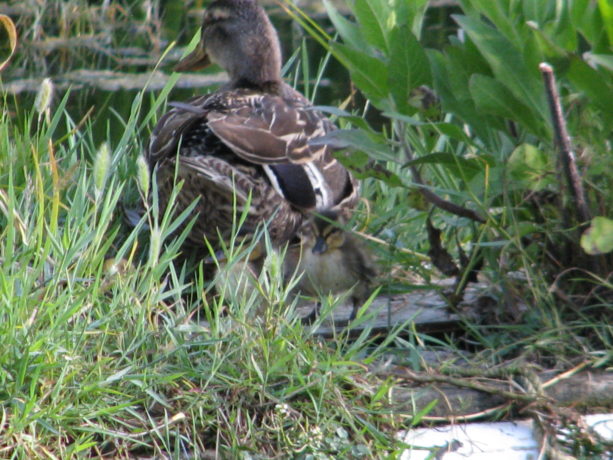
Almost everyone is tucked under for the night. After exploring a little, falling off a few times and grooming themselves, they tucked under their very good mama for a warm and safe sleep. Squeee!
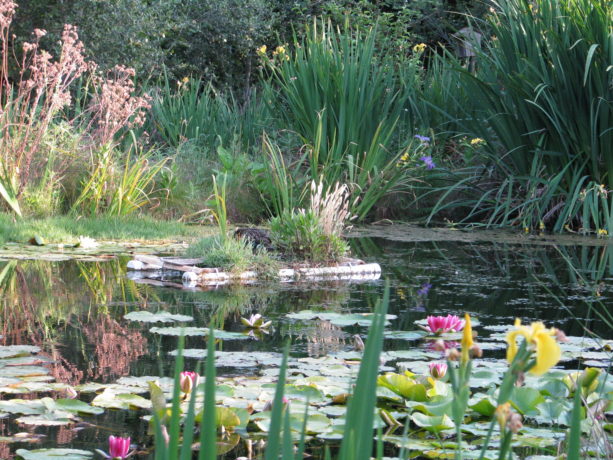
Safely afloat, Mrs. Mallard and children are tucked away for the night, safe from coyotes, raccoons, rats and snakes. - Animals, Arts and Crafts, Birding, Building and Landscaping, Gardening adventures, Houses, Natives, Permaculture and Edible Forest Gardening Adventures, Ponds, Predators, Water
A Mallard House

The Finch Frolic Garden Mallard Nesting Tube, by Miranda. For about four years now a pair of wild mallards have called Finch Frolic Garden home. They visit most of the year, especially in mating season as it is now. The male guards her closely as she goes off to lay an egg a day in some secluded, secret nest. This is Mrs. Mallard’s best time of the year.
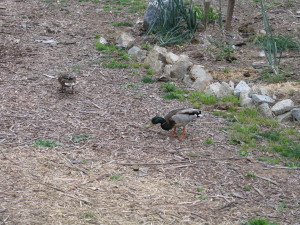
Mrs. Mallard leading her mate all over the property as he protects her. She’ll stroll all over the property while he has to follow, and it is hilarious to watch. They get in more walking time now than in the whole year put together. She deserves to enjoy the attention because the rest of mating season isn’t so much fun for her.
The mating occurs in the water, with the male biting her neck and holding her head under water. Ducks have drowned during mating. A couple of years ago Mr. Mallard was losing his mating plumage and decided to allow a rather mean drake have at Mrs. Mallard. It was a violent mating, and she tried hard to get away.
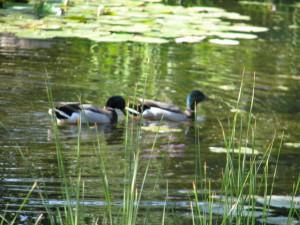
Mr. Mallard and his terrible surrogate. The next time the imposter flew in Miranda and I were close to the pond by a lime tree, with some bushes between us and the pond. Suddenly we noticed Mrs. Mallard slowly walking around the bushes, her head held low. If she could have tip-toed with webbed feet she would have. She slowly approached us and hid behind the lime tree next to us. We took action and chased the males away, then spoke soothingly to Mrs. Mallard in a sense of female solidarity. It was quite touching to have a wild creature so trust us as to come to us for rescue.
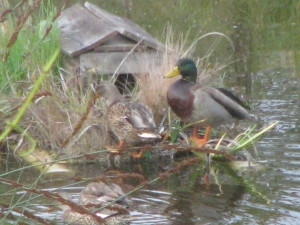
The Mallards checking out the duck island. Once the eggs have been laid the female is entirely in charge of the eggs and the hatchlings. However, if the clutch fails, the male will keep re-mating with her and she’ll keep re-nesting. Mrs. Mallard has attempted to lay eggs on our property in the bushes, but rats or other creatures have eaten them. She had a nest right next to our garage one year, perhaps hoping that we could protect the eggs even though by the time we realize why we’d meet a duck on the pathway by the house every day it was too late. The stress of the mating, the egg production and laying is taxing to a wild duck’s health. Last year she appeared leading several ducklings to our pond. We have no idea how far she’d lead them, or how many there were to begin with, and we knew the babies probably wouldn’t last long. We were right; they were gone by the next day. Predation by the invasive bullfrogs in the pond, rats, weasels, hawks or any number of animals. So sad for the mallard family.
This year Mrs. Mallard has been disappearing daily, obviously to lay an egg a day elsewhere again. However Miranda decided to help out for future nests. She built a mallard nesting tube. Following instructions she found online from people who have proven this design works, she rolled the first three feet of a piece of 7’x3′ hardware cloth to form a tube.
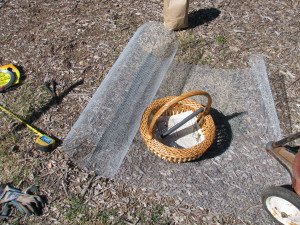
A 7′ x 3′ piece of hardware cloth. Larger wire would let too much debris fall into the pond. This was wired together, and the last four feet was layered with natural plant materials and rolled.
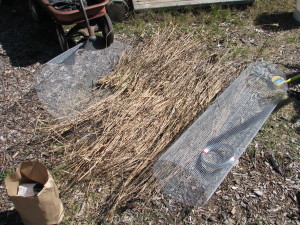
The first 3′ are rolled and fastened, then Miranda lay dry cattails on the rest. 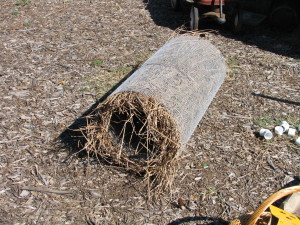
The nesting tube. Kind of like a jelly roll for mallards. 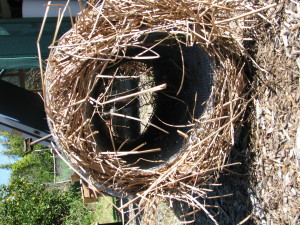
The inside of the tube isn’t large, but apparently it is large enough. This tube was wired onto a cradle she made mostly of recycled PVC parts, and painted dark green.
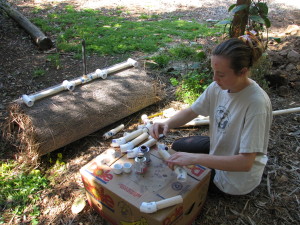
Gluing together the cradle. All of the pipe we had salvaged from old irrigation systems. 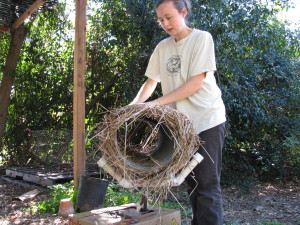
The cradle supports the tube, but is also loosely wired onto it. 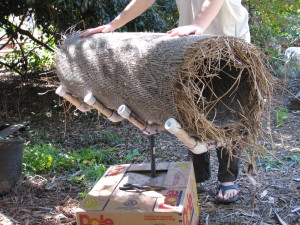
A sprinkler riser is what will fit into the support pipe. 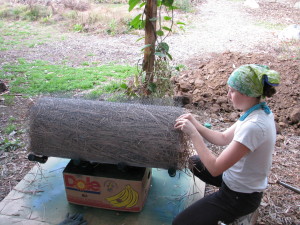 Also, to prevent hawks, egrets and other opportunistic birds from perching on top and snacking on eggs or hatchlings, Miranda attached strips of pokey chicken wire along the top.
Also, to prevent hawks, egrets and other opportunistic birds from perching on top and snacking on eggs or hatchlings, Miranda attached strips of pokey chicken wire along the top.
Since egrets visit the pond regularly, the top of the tube had to be inhospitable. 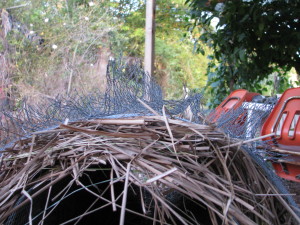
Miranda cut strips of chicken wire and these were bent and wired on top to prevent birds from landing. Slipping into the chilly February pond was a shock until our legs became acclimated (or “numb”). We pounded a hollow pipe, then slipped another pipe into it (both found materials), and then mounted the tube on top.
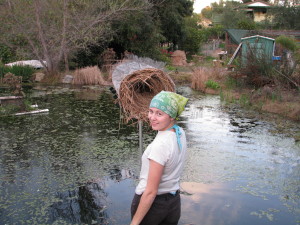
After mounting the nesting tube, Miranda stuffed leaves and dry grass inside, because mallards don’t carry in their own nesting materials. Miranda then lined the inside of the tube with soft nesting materials – dried grass and leaves – because mallards don’t bring them in. A little interior decorating for future lodgers. A sprinkler riser screwed into the PVC cradle slipped into the pipe. This way the nesting tube can be easily removed for maintenance. The tube is about three feet above the water surface.
Mrs. Mallard hasn’t shown any interest at this point, but she’s involved with her other nest right now. We have high hopes for a successful nest. Anyone want to come catch bullfrogs?
- Animals, Birding, Compost, Fungus and Mushrooms, Gardening adventures, Hugelkultur, Humor, Microbes and Fungi, Natives, Other Insects, Perennial vegetables, Permaculture and Edible Forest Gardening Adventures, Ponds, Predators, Rain Catching, Reptiles and Amphibians, Seeds, Soil, Water, Water Saving, Worms
Ponds and Potatoes; A Finch Frolic New Year’s Celebration
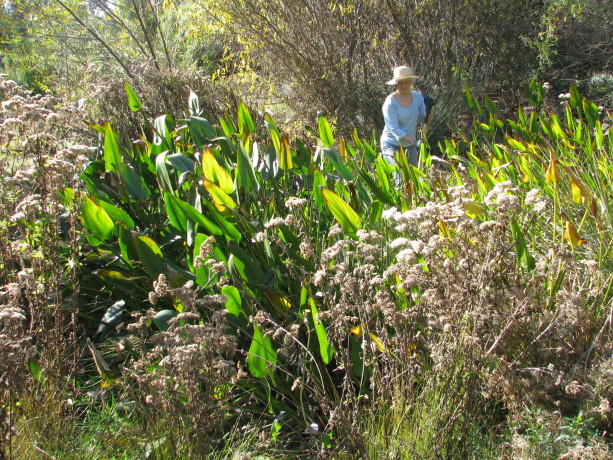 Our sixty degree weather here in Fallbrook, CA , gave us the opportunity to work in our garden. A year ago – 2014 – it snowed on New Year’s Eve. This year the nights are frosty, the days mercifully warmer, and the rain frustratingly rare. Our promised El Nino rains are expected to hit in force within the next couple of months. Weather they do or not, focusing on catching every precious drop in the soil, and protecting the ground from erosion and compaction, is paramount.
Our sixty degree weather here in Fallbrook, CA , gave us the opportunity to work in our garden. A year ago – 2014 – it snowed on New Year’s Eve. This year the nights are frosty, the days mercifully warmer, and the rain frustratingly rare. Our promised El Nino rains are expected to hit in force within the next couple of months. Weather they do or not, focusing on catching every precious drop in the soil, and protecting the ground from erosion and compaction, is paramount.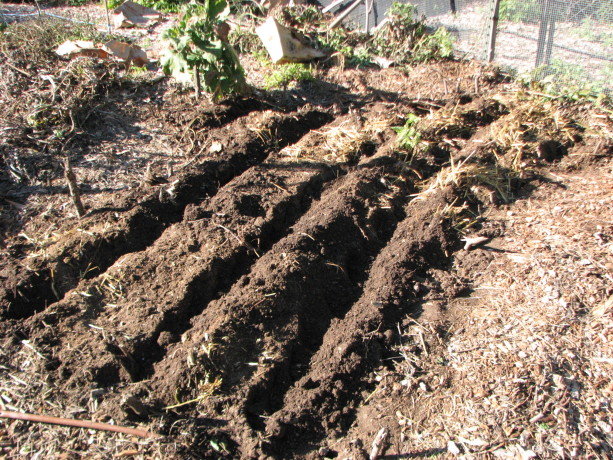
Permaculture in rows. Pretty nice soil, which had been silt from the street a couple of years ago, mixed with chicken straw, topped with leaves. No chemicals! The last day of 2015 Miranda and I spent working one of our vegetable garden beds, and reshaping our kitchen garden. When we redesigned this garden by removing (and burying) the raised beds, hugelkulturing and planting, we made a lovely Celtic design.
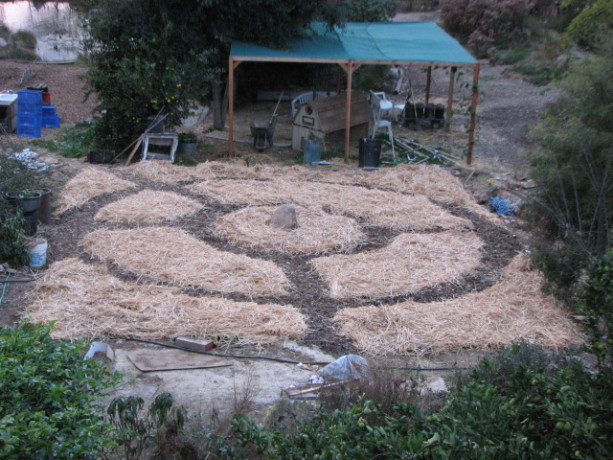
The unplanted kitchen garden newly designed in January, 2013. However the plants just won’t respect the design, so we’ve opted to lessen the pathways, turning the beds into keyhole designs for more planting space. I’ll blog more about that in the future. Because the pathways have been covered in cardboard and woodchips (sheet mulched), the soil below them is in very good shape, not dry and compacted.

How deep do roots grow? This clump of oxalis (sour grass) is white because it was growing without light under the pathway sheet mulch. The corms at the end of the long roots are about 8 inches below the plant. Good soil means deep roots; I’ve never seen this plant have anything but shallow roots. This bed has been home to sweet potatoes and various other plants, so although I try to practice the no-dig method, where you have root vegetables you must gently probe the soil for goodies. We left some of the roots, so sweet potatoes will again rise in this bed.

Miranda planting potatoes and shallots in rows. Between these rows and around the outisde other veggies were planted. We planted in rows. Usually I mix up seeds, but this time I wanted to demonstrate polyculture in row form. We planted three rows of organic potatoes (purchased from Peaceful Valley Organics), with a row of shallots between them. Between the root vegetable rows we planted a row of fava beans, and a row of sugar pod peas. Around the edges Miranda planted rows of bull’s blood beets, Parisienne carrots, and maybe some parsnips. This combination of plants will work together in the soil, following the template of a plant guild. We left the struggling eggplant, which came up late in the year after the very hot summer and has so far survived the light frost.
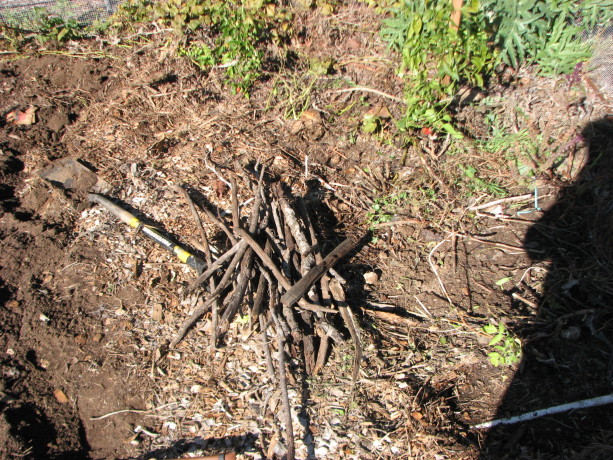
Sticks. So important for the soil. These went in vertically around the planting bed to act both as one type of gopher deterrent (a physical barrier) and also as food and as water retention for the veggies. On top of the bed we strew dead pond plants harvested from our small pond near our house, which will be receiving an overhaul soon (hopefully before the Pacific chorus frogs start their mating season in force). We didn’t water the seeds in, as there is rain predicted in a few days. The mulch on top will help protect the seeds from hungry birds.
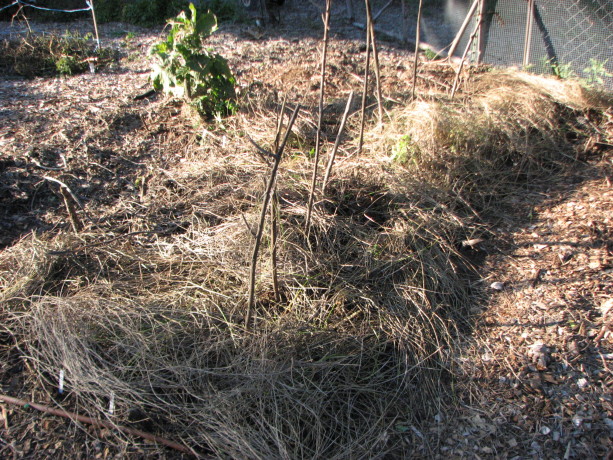
The finished bed topped with dead pond weeds (which don’t have seeds that will grow on dry land!). The sticks are to steady future bush peas. A good way to spend the last day of the year: setting seeds for food in the spring.
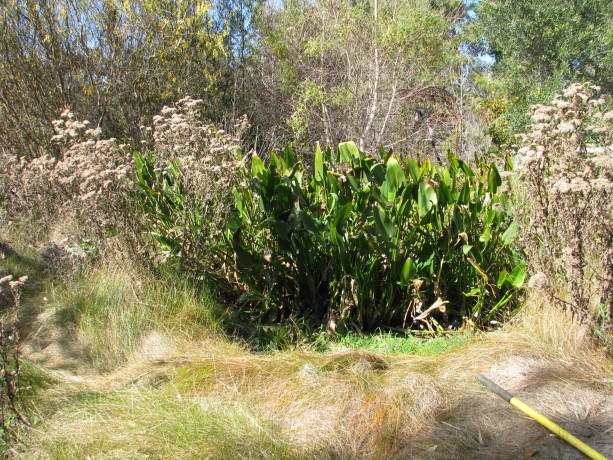
Before: The little pond, which is also a silt basin, almost completely filled by an enthusiastic clump of pickerel. This pond is wonderful habitat for birds, frogs, dragonflies, and so many other creatures, and as a water source for raccoon, possum, coyotes, ducks, and who knows what else that visits in the night. Then on January 1 I decided it was a good opportunity to clear out the excess pickerel that had taken over our lower small pond. With the well off for the winter, and very light rainfall, this pond has gone dry. A perfect opportunity for me to get in there with a shovel, especially knowing that I already had a chiropractor’s appointment set for Monday (!).

Making some headway. The mud was slick and spongy, but not unsafe, and not nearly as smelly as I had anticipated. Pickerel is not a native to San Diego, but it is a good habitat pond plant and it has edible parts. I wasn’t tempted, however. Its roots are thick and form a mat several inches thick hiding rhizomes that are up to an inch in diameter. I’d cut into the mass from several sides, pull the mass out with my gloved hands and throw the heavy thing out of the pond. Its good to be in contact with the earth, in all its forms. I couldn’t think of a better way to use the holiday afternoon.
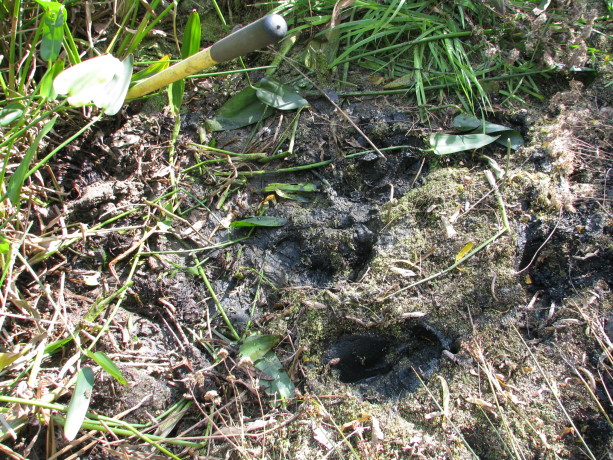
Thick root mass hiding large rhizomes made removal a real exercise. This is why I practice yoga and attend Zumba class with Ann Wade at the Fallbrook Community Center! I moved at least a ton of material in four hours. Just before sunset I decided that I was done. About an hour before that, my body had decided that I was done, but I overrode its vote to finish. I left some pickerel for habitat and looks, and will try to contain it by putting some sort of a physical barrier along the roots, such as urbanite.
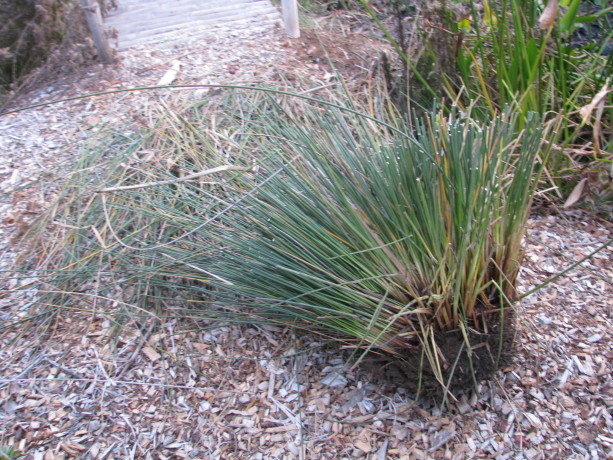
Removal of one of the three really nasty plants around the edge was a victory. The ends of their leaves are like needles, and impossible to walk past or work around, and dangerous for little kids. This root ball was harder to dig out than the mucky pickerel, and the success even sweeter. Revenge for all the pokes! We also might harvest some of the silty clay for use in the upper pond, although the prospect of carting heavy wet mud uphill isn’t as appealing as it might sound. That needs to happen today or tomorrow, as the aforementioned rain is expected, and I want to fill this pond again for the frogs.
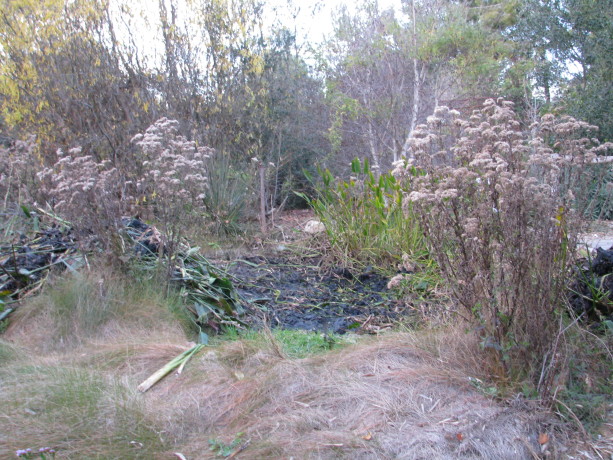
After: Finished with the digging. Still more work to do -including cleanup of the mountain of organic matter – before refilling. One good thing about the pond going dry is that there are no more mosquito fish (gambuzia) in it. Mosquito fish are very invasive, and love to eat frog’s eggs and tadpoles far better than they do mosquito larvae. When the pond fills with non-chemically treated water (rain and well water), some of the microscopic aquatic creatures will repopulate the water. I’ll add some water from the big pond as well to make sure there are daphnia and other natural water friends in it, which will do a much better job at mosquito control without sacrificing our native frogs. I can’t get all the gambuzia out of our big pond, but at least they are out of the other two. Once dragonflies start in again, their young will gladly eat mosquito larvae.
So here on the morning of the second day of 2016, I lay in my warm bed prior to rising to start the chores of the day, stiff as an old stiff thing as my body adjusts to strenuous manual labor again, looking forward to more gardening duties to prepare Finch Frolic Garden for the reopening March 1, and for the rains.
The best part of heavy gardening duties is that I can finish off the Christmas cookies guilt-free!
- Animals, Birding, Building and Landscaping, Chickens, Compost, Fungus and Mushrooms, Gardening adventures, Health, Heirloom Plants, Houses, Hugelkultur, Microbes and Fungi, Natives, Other Insects, Perennial vegetables, Permaculture and Edible Forest Gardening Adventures, Ponds, Predators, Rain Catching, Reptiles and Amphibians, Seeds, Soil, Water, Water Saving
Podcasts with Diane Kennedy
Two podcasts with me talking about permaculture, Finch Frolic Garden, and how you can save money and the world through gardening! 🙂 Please let me know what you think:
This is a podcast with Sheri Menelli of earthfriendlyhomeowner.com, where I talk pretty much without a pause for breath for about the first ten minutes. Recorded in May, 2015.
http://www.earthfriendlyhomeowner.com/ep7-interview-with-diane-kennedy-of-finch-frolic-gardens-and-vegetariat-com/
This is a podcast with Greg Peterson of Urban Farm Podcasts, released Jan. 7, 2016, and you can listen to it several ways:
Urban Farm U:
http://www.urbanfarm.org/category/podcast/
iTunes:
https://itunes.apple.com/us/podcast/urban-farm-podcast-greg-peterson/id1056838077?mt=2
You can sign up for free to hear all their great podcasts here.
- Dessert, Fruit, Gardening adventures, Herbs, Special Events, Spices, Vegan, Vegetables, Vegetarian, Water Saving
Our Annual Marketplace, and Last Tours of 2015
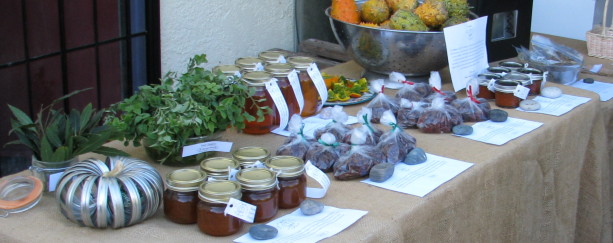 Our fourth-annual Finch Frolic Marketplace will take place Nov. 21 and 22nd from 9 – 2. We’ve been working like little permaculture elves, harvesting, preparing fruit and vegetables, canning, baking, and inventing new recipes for your table and for gifts. We have a curry spice mixture that is amazing. Our record white guava harvest has allowed us to create sweet guava paste and incredible guava syrup. We’ve pickled our garlic cloves, as well as zucchino rampicante, and our Yucatan Pickled Onions have a wonderful orange and oregano base that is fabulous. Of course there is Miranda’s small-batch Pomegranate Gelato, Whiskey-Baked Cranberry Relish, and a selection of curds (passionfruit, lemon-lime, and cranberry). So much more, too. We’ll also be selling plants from several sources, and some collectibles and knick-knacks from my home. Please come support a small business early – a whole week before Small Business Saturday! Your patronage allows us to continue teaching permaculture.
Our fourth-annual Finch Frolic Marketplace will take place Nov. 21 and 22nd from 9 – 2. We’ve been working like little permaculture elves, harvesting, preparing fruit and vegetables, canning, baking, and inventing new recipes for your table and for gifts. We have a curry spice mixture that is amazing. Our record white guava harvest has allowed us to create sweet guava paste and incredible guava syrup. We’ve pickled our garlic cloves, as well as zucchino rampicante, and our Yucatan Pickled Onions have a wonderful orange and oregano base that is fabulous. Of course there is Miranda’s small-batch Pomegranate Gelato, Whiskey-Baked Cranberry Relish, and a selection of curds (passionfruit, lemon-lime, and cranberry). So much more, too. We’ll also be selling plants from several sources, and some collectibles and knick-knacks from my home. Please come support a small business early – a whole week before Small Business Saturday! Your patronage allows us to continue teaching permaculture.Our last two Open Tours will also be held that weekend, each at 10 am. The tours last about two hours and we should be having terrific weather for you to enjoy learning basic permaculture as we stroll through the food forest. Please RSVP for the tours to dianeckennedy@prodigy.net. More about the tours can be found under the ‘tours’ page on this blog.
Finch Frolic Garden will be closing for the winter, from Thanksgiving through March 1. However, Miranda and I will still be available for consultations, designs, lectures and workshops, and we will be adding posts to Vegetariat and Finch Frolic Facebook (you don’t need to be a member of Facebook to view our page!).
Have a very safe and very happy holiday season. Care for your soil as you would your good friends and close family, with swales, sheet mulch and compost, and it will care for you for years.
Diane and Miranda
